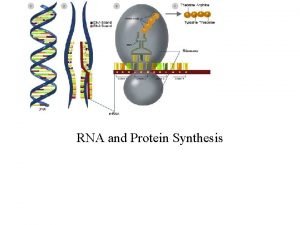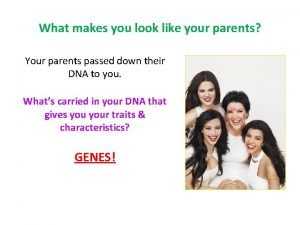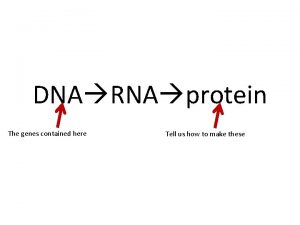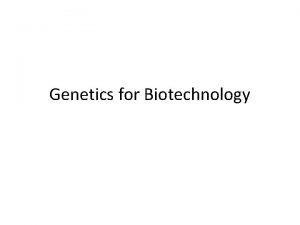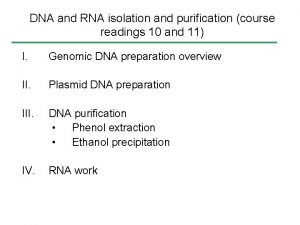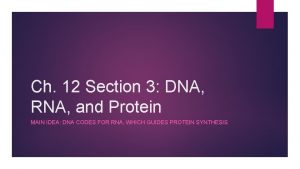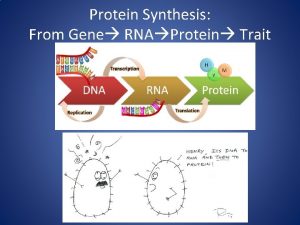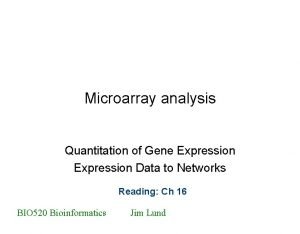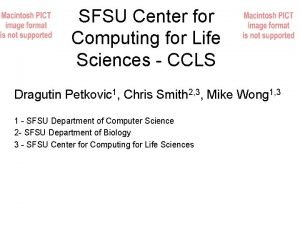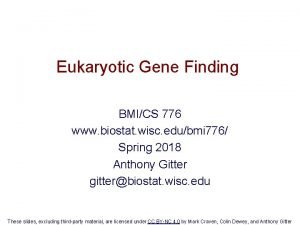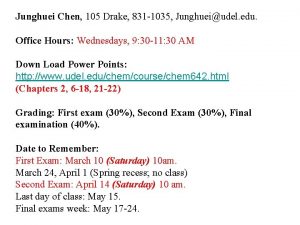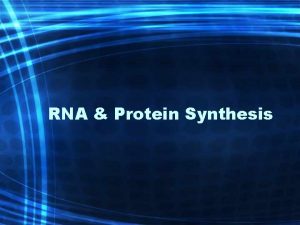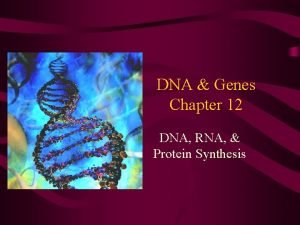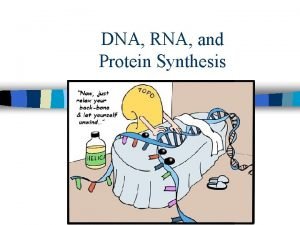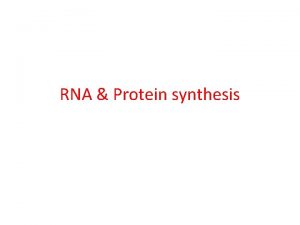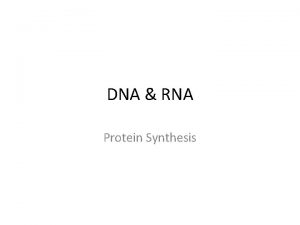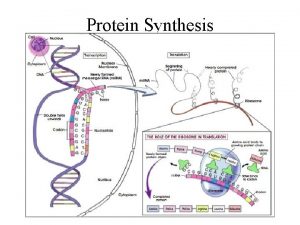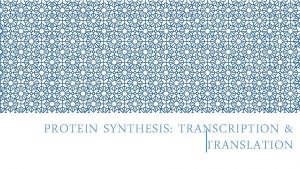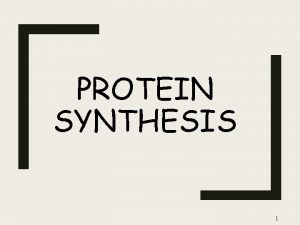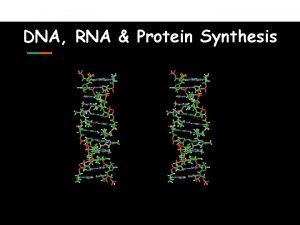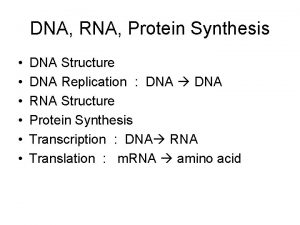RNA Protein Synthesis I DNA to Genes A


















- Slides: 18

RNA & Protein Synthesis

I. DNA to Genes • A. We now know how the double helix is replicated but we still don’t know how it is then transformed into genes. • B. Remember genes are coded DNA instructions that control the production of proteins within the cell. • C. A little sequence from DNA is copied and transferred into RNA, which then carry the sequence to make proteins

II. What is RNA: Structure of RNA • A. RNA consists of a long single stranded chain of nucleotides. • B. The 3 parts of a RNA nucleotide: – 1. 5 carbon sugar ribose – 2. Phosphate group – 3. Nitrogenous bases : Adenine, Guanine, Cytosine & Uracil • C. RNA can be a disposable copy of a tiny segment of DNA that carries a sequence for a single gene

III. Types of RNA • A. There are 3 main types of RNA: – 1. messenger RNA – carry the copy of DNA to the rest of the cell (m. RNA) – 2. ribosomal RNA – make up ribosomes which make proteins (r. RNA) – 3. transfer RNA – carry an amino acid to the ribosome (t. RNA) • B. The 3 types of RNA play a key role in protein synthesis


IV. Transcription • A. Transcription is the process in which RNA molecules are produced by copying a specific part of the DNA sequence. • B. During transcription RNA polymerase binds to DNA and separates the DNA at a promoter site using 1 DNA strand as a template. – 1. promoter – a section of DNA with a specific base sequence that indicates to RNA polymerase to bind and begin transcription

V. RNA Editing • A. RNA molecule require a little bit of editing getting copied directly from DNA. • B. DNA in eukaryotic cells have sections of nucleotides called introns that are not involved in coding for proteins • C. The sequences that code for proteins on DNA are known as exons. (expressing sections) • D. Prior to leaving the nucleus the introns are cut out and the exons are spliced back together


VI. Genetic Code • A. Proteins are made by joining the 20 different amino acids into long chains called polypeptides – 1. the sequence of the amino acids determines the protein • B. The genetic code from the DNA transcribed into m. RNA is read 3 letters at a time making each amino acid a different 3 letter “word” • C. The 3 letter word along the m. RNA is called the codon the t. RNA that carries the amino acid to match the codon is called the anticodon.


• 1. There are over 64 possibilities of codons but only 20 amino acids so many codons may read for the same amino acid. • 2. There is also a very specific codon (AUG) that is known as a start/stop codon that starts/ends protein synthesis – Ex. DNA Sequence: AGC GTG m. RNA Sequence codon: UCG CAC Amino Acid that will match: Serine Histidine

Anticodons

VII. Translation • A. In order for proteins to be made from the m. RNA the ribosome has to carry out its main job – 1. Decoding the m. RNA message into a polypeptide chain is known as translation • B. As the m. RNA is moves through the ribosome t. RNA brings the correct amino acid to the ribosome assembles the amino acids into a chain it releases the t. RNA again • Once the ribosome reaches a stop codon the polypeptide chain as well as the m. RNA are released as well


IIX. Mutations • A. Mutations are changes in the genetic material. • B. 2 types of mutations: – 1. Gene mutations – changes in a few nucleotides can cause either point mutations or frameshift mutations • Ex. TAC GCA -> AUG CGU -> Met Arg • TAC GTA -> AUG CAU -> Met His – 2. Chromosomal mutations – changes in the structure of the chromosome caused by deletion, duplication, inversion, translocation


IX. Comparing Roles of DNA & RNA A. DNA • • • 1. Double stranded 2. Deoxyribose 3. Thymine 4. Never leaves nucleus 5. “Master plan” B. RNA • • • 1. Single stranded 2. Ribose 3. Uracil 4. Enter & leave nucleus 5. “Blueprint”

X. Why Proteins are Important • A. Remember proteins are created from your DNA sequence which are your genes. – 1. the sequence will identify the protein being made, that protein can regulate chemical reactions & catalyze others. • Ex. Enzymes can produce color pigment in a flower or are proteins that regulate growth
 Dna rna protein synthesis homework #2 dna replication
Dna rna protein synthesis homework #2 dna replication Dna protein synthesis study guide answers
Dna protein synthesis study guide answers Section 12-3 rna and protein synthesis answer key
Section 12-3 rna and protein synthesis answer key Rna protein synthesis
Rna protein synthesis Rna transfer
Rna transfer Totipotent cell
Totipotent cell Dna rna protein central dogma
Dna rna protein central dogma Dna rna protein
Dna rna protein Dna rna protein central dogma
Dna rna protein central dogma Dna rna protein diagram
Dna rna protein diagram Chapter 12 section 3 dna rna and protein
Chapter 12 section 3 dna rna and protein Protein
Protein Microarray analysis
Microarray analysis Linked genes and unlinked genes
Linked genes and unlinked genes Genepattern
Genepattern Linked genes and unlinked genes
Linked genes and unlinked genes Non protein coding genes
Non protein coding genes Non protein coding genes
Non protein coding genes Synthesis of rna
Synthesis of rna




